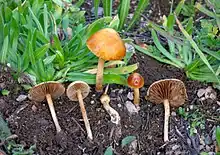Agrocybe pediades
Agrocybe pediades is a typically lawn and other types of grassland mushroom,[1] but can also grow on mulch containing horse manure. It was first described as Agaricus pediades by Swedish mycologist Elias Magnus Fries in 1821, and moved to its current genus Agrocybe by Victor Fayod in 1889. A synonym for this mushroom is Agrocybe semiorbicularis, though some guides list these separately.[2] Technically it is edible, but it could be confused with poisonous species, including one of the genus Hebeloma.
| Agrocybe pediades | |
|---|---|
 | |
| Scientific classification | |
| Domain: | Eukaryota |
| Kingdom: | Fungi |
| Division: | Basidiomycota |
| Class: | Agaricomycetes |
| Order: | Agaricales |
| Family: | Strophariaceae |
| Genus: | Agrocybe |
| Species: | A. pediades |
| Binomial name | |
| Agrocybe pediades | |
| Synonyms | |
| Agrocybe pediades | |
|---|---|
| Gills on hymenium | |
| Cap is convex | |
| Stipe is bare | |
| Spore print is brown | |
| Ecology is saprotrophic | |
| Edibility is edible | |
Description
The mushroom cap is 1–3 cm wide, round to convex (flattening with age), pale yellow to orange-brown, smooth, sometimes cracked, and tacky with moisture but otherwise dry.[3] The stalks are 2–5 cm tall and 1–3 mm wide.[3] A partial veil quickly disappears, leaving traces on the cap's edge,[3] but no ring on the stem.[4] The cap's odor and taste are mild or mealy.[3]
The spores are brown, elliptical, and smooth.[3] Some experts divide A. pediades into several species, mainly by habitat and microscopic features, such as spore size. It is recognized by the large, slightly compressed basidiospores which have a large central germ pore, 4-spored basidia, subcapitate cheilocystidia and, rarely, the development of pleurocystidia.[5]
This species is edible, but it could be confused with poisonous species, including one of the genus Hebeloma.[6] Some field guides just list it as inedible[2] or say that it is not worthwhile.[4]
Similar species
Similar species include Agrocybe praecox and A. putaminum.[3]
References
- "Agrocybe pediades - GBIF Portal". Global Biodiversity Information Facility. Retrieved 2009-11-01.
- Phillips, Roger (2010). Mushrooms and Other Fungi of North America. Buffalo, NY: Firefly Books. pp. 226–27. ISBN 978-1-55407-651-2.
- Davis, R. Michael; Sommer, Robert; Menge, John A. (2012). Field Guide to Mushrooms of Western North America. Berkeley: University of California Press. pp. 238–239. ISBN 978-0-520-95360-4. OCLC 797915861.
- Trudell, Steve; Ammirati, Joe (2009). Mushrooms of the Pacific Northwest. Timber Press Field Guides. Portland, OR: Timber Press. p. 179. ISBN 978-0-88192-935-5.
- Bókaútgàfa Menningarsjóds Timarit um islenzka grasafrædi, ed. 7–12, pg. 5, Reykjavík (1984)
- Miller Jr., Orson K.; Miller, Hope H. (2006). North American Mushrooms: A Field Guide to Edible and Inedible Fungi. Guilford, CN: FalconGuide. p. 271. ISBN 978-0-7627-3109-1.